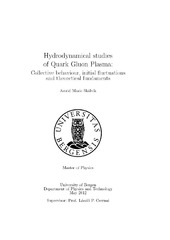Hydrodynamical studies of Quark Gluon Plasma: Collective behaviour, initial fluctuations and theoretical fundaments
Master thesis
Permanent lenke
https://hdl.handle.net/1956/7168Utgivelsesdato
2012-05-30Metadata
Vis full innførselSamlinger
Sammendrag
This master thesis focuses on collective behaviour of the Quark Gluon Plasma, created at the Large Hadron Collider at CERN. We calculate analytically and semi-analytically the transverse momentum and rapidity dependence of the ow components v1 and v2. The most important result here is that the global ow component v1 is predicted to no longer peak at negative rapidities for the LHC energies, due to a rotational effect from the initial angular momentum of the system. However, this will be overshadowed by initial state uctuations of the center of mass rapidity, that appear as the positions of the nucleons uctuate in the transverse plane. This smoothing out by initial state uctuations is then included in the expressions of v1 and v2. Then we investigate how the Time Projection Chamber (TPC) and the Zero Degree Calorimeter (ZDC) detector limitations will distort the measures of the center of mass rapidity yCM and pseudorapidity etaCM . We show how it is possible to simulate the system after a 1.38 + 1.38 A.GeV Pb + Pb collision with an impact parameter b = 0.5bmax. The post-collision particles were assumed to follow a pion-Juttner distribution, emitted from a single or several thermal sources at temperature T = 0.1 GeV. The TPC detector limitation of pseudorapidity less than 0.9 is then taken into account. We also model the ZDC detector response by implementing in our simulation that the ZDC can only detect single neutrons, as charged fragments are de ected by magnetic fields. The TPC and ZDC will then report a yCM that is only a fraction of what would be detected by an ideal Large Array Detector (LAD). The conclusion is that the detector distortions have to be taken into account to avoid underestimating the yCM. We also provide a graph showing the expected yZDC CM vs etaTPC CM as this could later be compared to experimental data.
